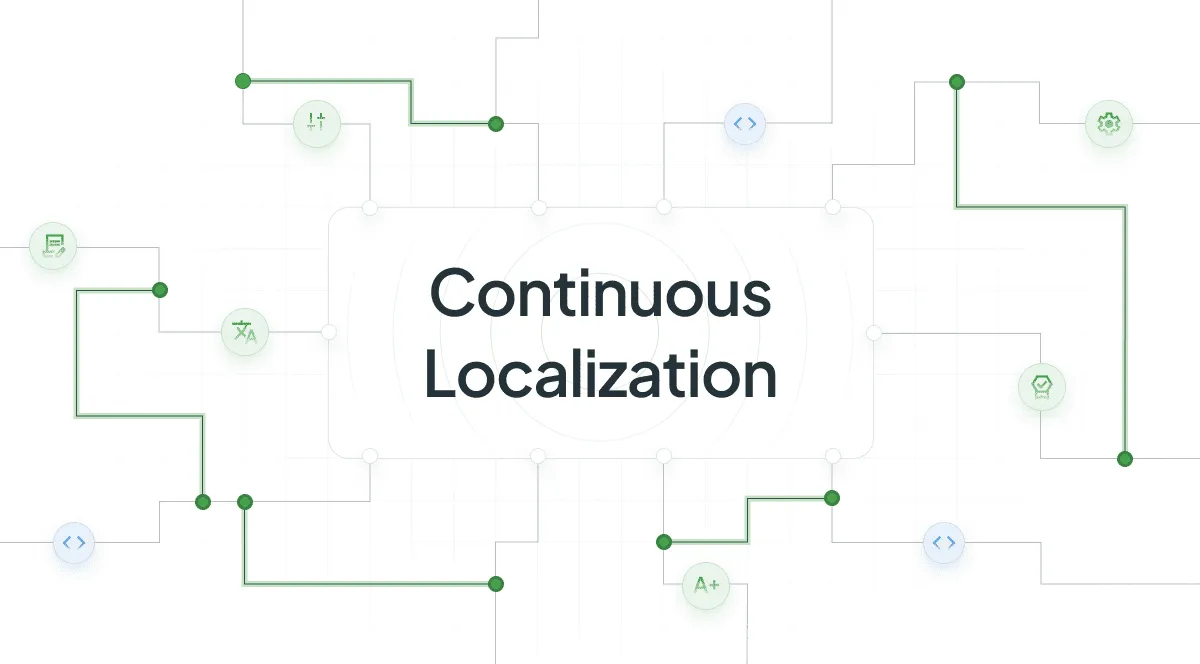In the world of modern software, websites, and apps, there’s no such thing as a “finished” product. Your team is always working on the next update – a new button, a better menu, or a small fix to a bug. These changes happen all the time, not just once a year.
This constant flow of updates creates a huge challenge for the localization team. Every single text change, no matter how minor, needs to be translated for all of your available languages. Waiting for a “final” version to start translating is impossible because the product is never truly done. This traditional method just holds everything up.
Continuous localization is the solution. It’s an automated process that makes sure even the smallest updates are translated and ready to go in every language immediately. Continuous localization works in real-time, keeping up with the speed of your development team. This is how all your users in every language always see the latest, most accurate content, without any delays.
What is Continuous Localization?
Continuous localization is an agile approach to translation and localization that automates the process of identifying, extracting, and translating new content as it’s added to a product. It integrates localization directly into the software development workflow. This ensures new features and updates are ready for global markets as soon as they’re released.
Unlike the “batch-and-wait” method, with continuous localization content gets translated as soon as it’s created. This reduces time-to-market for global releases. The process is powered by a few key principles:
- Automation. Using tools like Crowdin, new text strings are automatically detected in your source code. They are then sent for translation and pushed back to the product once the translation is complete.
- Integration. The localization platform links directly with your development tools, such as GitHub or GitLab, creating a flow of information.
- Incremental Translation. Instead of translating thousands of words at once, translators work on small, manageable batches of new content as they appear.
- Real-Time Collaboration. Developers, translators, and project managers work together in a single, unified environment. This cuts down on communication delays and manual file transfers.
Why Continuous Localization is a Necessity
The waterfall approach simply doesn’t work for the way most businesses operate today. When your development team pushes new code daily, you won’t see the finished product. Continuous localization is the only way to keep pace.
Time to Market
In a global market, being first matters. With a continuous localization process in place, new features and products can be launched in multiple languages at the same time. With continuous localization, you can avoid the long delays of traditional translation. You no longer have to choose between a fast launch and a localized one – you get both.
Enhanced User Experience
When international users see new features in English, but not in their native language, it’s frustrating. But with continuous localization, your customers can always access the latest updates in their own language.
Brand Consistency
When different people translate at different times, your brand’s voice can lose its consistency. A centralized localization platform like Crowdin ensures consistency among all translators. It provides them with the same resources, such as glossaries and style guides. This guarantees that your messaging and tone remain consistent across all markets.
Cost Efficiency
Continuous localization might seem complex to set up, but it can lead to cost savings in the long run. By automating repetitive tasks, you reduce the time and effort your team spends on manual file management. Furthermore, continuous localization uses technologies like Translation Memory (TM) and Machine Translation (MT). TM reuses previously translated content, so you never pay to translate the same phrase twice. And MT can handle high-volume, low-risk content instantly.
Ajax Systems Localization: 3 Times Cheaper, 2 Times Faster, No Quality Loss.
What Content Needs Continuous Localization?
Continuous localization is necessary for any digital product that is not a static, one-time deliverable. This includes content that is constantly being updated, improved, and changed.
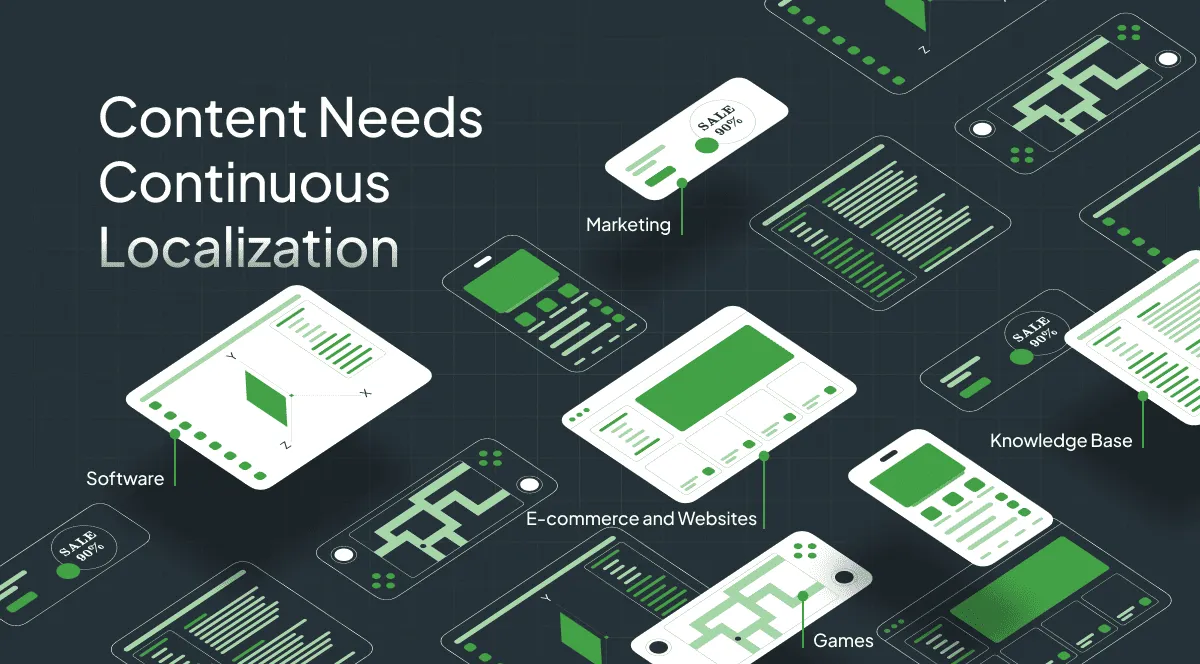
The content that benefits most from a continuous localization workflow includes:
- Software: For software platforms, continuous localization is essential for translating new features, UI text, and bug fixes as they are added. That’s why new updates can be released to all global users at the same time.
- Apps: For mobile apps, continuous localization allows for the real-time translation of interface text and new functionality. This guarantees a current mobile experience in every language.
- Websites: Сontinuous localization is perfect for websites with a focus on content, as new blog posts, landing pages, and web content can be localized as soon as they are published.
- E-commerce: For online stores, continuous localization provides the quickest way to update product descriptions, promotional content, and sales pages in real time across all storefronts.
- Gaming: In the gaming industry, new quests, dialogue, and items are frequently released. Сontinuous localization makes sure all players get the new content at the same time, regardless of language.
- Marketing materials: Marketing content like email campaigns and social media posts needs to be adapted for different cultures to resonate with local audiences. Сontinuous localization provides an improved way to handle these frequent updates.
- Customer support content: Knowledge base articles, help documentation, and FAQs are often updated. This localization method keeps information always current across all languages, improving the user experience.
The Old Way: Understanding Waterfall Localization
Before, the standard was waterfall localization. This is a linear approach where the entire project is fully developed and finalized before any localization work begins. It’s a consistent process, like a waterfall flowing in one direction. You can’t start the next phase until the last one is completely done.
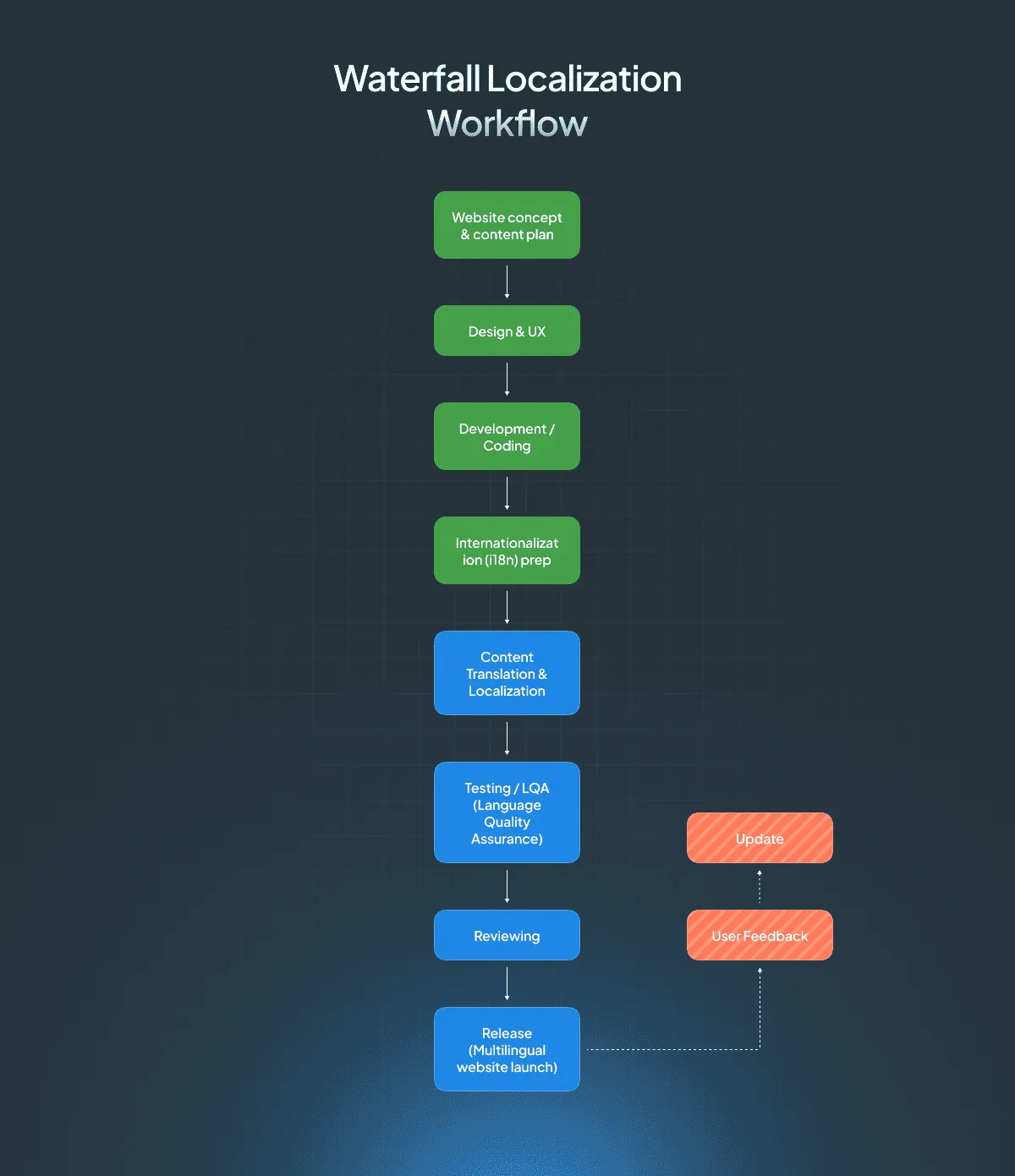
Who uses waterfall localization?
Even today, some teams rely on this method because of their specific needs. It’s not a bad process, just a different one.
- Regulated Industries. Sectors like the medical, legal, or financial industries often use the waterfall model. They need a meticulous, documented process where content is fixed after official approval. In a medical device manual or a legal contract, every version must be reviewed and signed off on, making a fixed, linear process.
- Projects with Static Content. For a company’s annual report, a one-time event website, or a user manual for an old product, the waterfall model works well. The content is static, and there’s no need for continuous updates.
The waterfall model provides a predictable timeline and budget for these types of projects. However, it’s completely unsuited for the rapid, iterative nature of modern software, which is what led to the need for a new way of thinking.
Continuous Localization Workflow
So, how does this automated process actually work? In a continuous localization workflow, your development environment and your localization team are connected in a single, ongoing loop. With Crowdin TMS, this entire process is automated. So now your team can focus on their work without worrying about manual file transfers or communication delays.
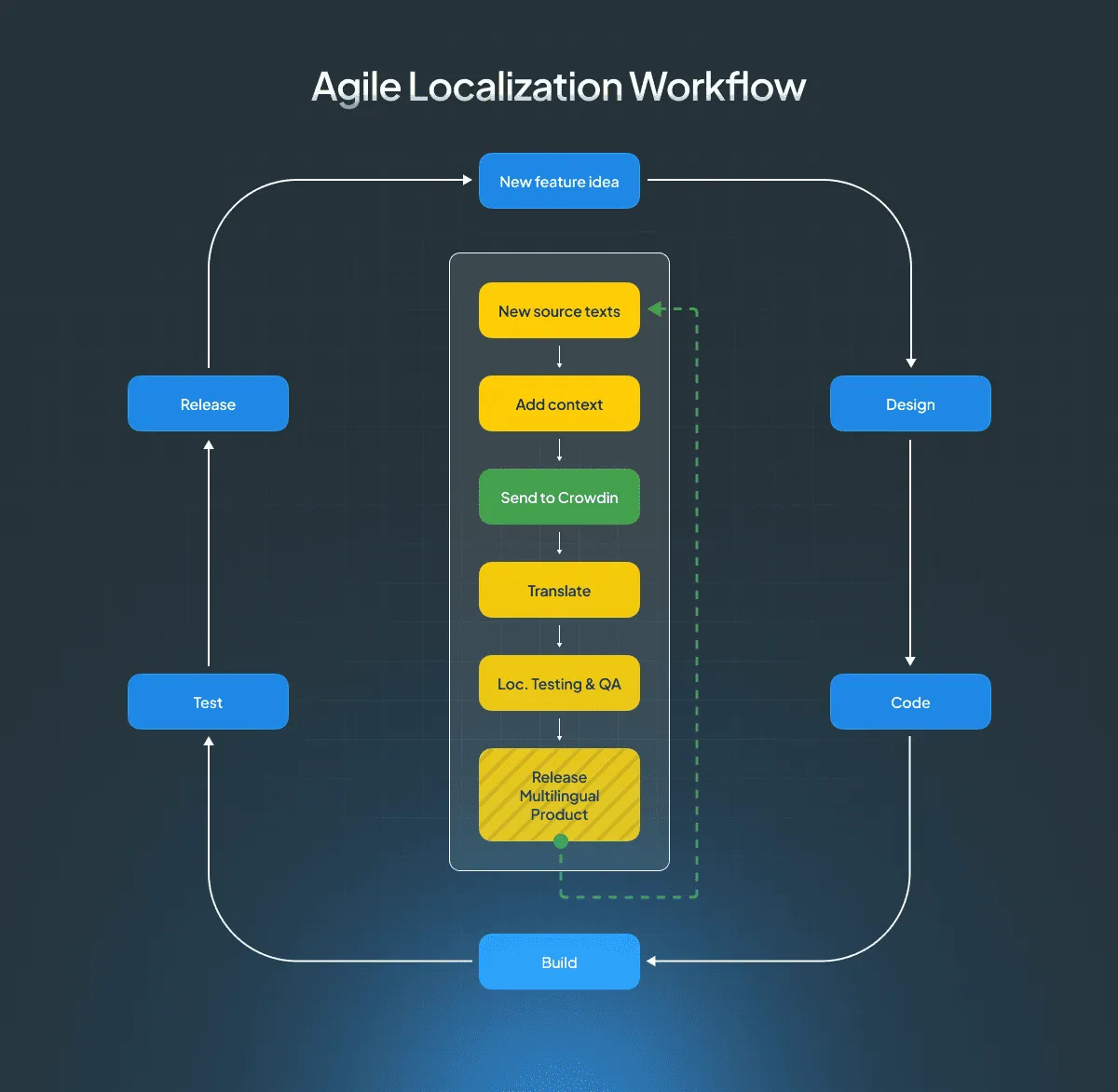
Here is a typical workflow, from a new line of code to a fully translated product:
- Source Code Integration. The first step is to connect your localization platform to your Version Control System (VCS), such as GitHub, GitLab, or Bitbucket. This creates a link between your code repository and your translation project.
- Automated Content Detection. The platform constantly monitors your source files. As soon as a developer pushes a new or updated text string, the system automatically detects the change.
- Automatic Synchronization. New text strings are automatically extracted from your source files and synchronized with the localization project. This happens in the background, so your developers don’t have to manually export anything.
- Translator Workflow. The localization team (in-house translators or a Language Service Provider) is notified of new content. They log into the platform and begin translating the new strings right away.
- Quality Assurance. As translations are completed, the system performs built-in QA checks to catch errors, such as missing variables or incorrect tags. Reviewers can also check the translations to ensure high quality and consistency.
- Translation Delivery. Once a translation is approved, it’s automatically sent back to your source code.
- Deployment. Finally, your development team merges the new translations into the next release.
This automated loop is what makes continuous localization a powerful solution for the development cycle. It transforms localization from a bottleneck into an integrated, parallel process.
But understanding the theory is just the first step. Next, we’ll dive into the practical side of things, showing you exactly how to set up and manage this workflow using a powerful platform.
How to Set up Continuous Localization with Crowdin
To start with continuous localization, you need to connect your development process to your localization workflow. Here’s a breakdown of the clear steps you’ll follow to set up a project using Crowdin.
Step 1: Connect Your Code Repository
The first and most critical step is to integrate your version control system with Crowdin. This creates a live link between your source code and your localization project.
- From the Crowdin dashboard, you’ll select your VCS provider (e.g., GitHub, GitLab, Bitbucket, or Azure Repos).
- Follow the on-screen prompts to authorize the connection.
- Next, select the specific repository you want to link.
Step 2: Configure Your Project
Once connected, you need to tell Crowdin exactly what content to localize.
- Choose which files and folders in your repository contain the text strings that need to be translated (e.g.,
.json,.yml,.xml,.strings). - Select all the languages you plan to translate your product into. Crowdin will automatically create translation files for each of these languages.
- Configure how Crowdin pulls and pushes content. You can set it to automatically pull new content as soon as it’s added to a specific branch (like main) and to push finished translations back to a separate translation branch.
Step 3: Add Your Localization Resources
To ensure quality and consistency, you’ll add all of your linguistic resources to the project.
- Connect Content Sources. Crowdin offers over 700 apps and integrations with popular CMS, marketing, and eCommerce platforms, as well as communication tools (like Zendesk, Mailchimp, and Webflow). This makes it easy to automatically sync content from all your digital channels.
- Upload a Glossary. Add a list of key terms and their approved translations to maintain consistent terminology.
- Import Translation Memory. Upload any existing translations from past projects. This saves your team time and money by reusing previous work and ensuring consistency with legacy content.
- Integrate Machine Translation. Connect to your preferred MT engine (like DeepL or Google Translate) to provide instant translation suggestions for translators.
Step 4: Invite Your Team
With the project configured, it’s time to add your team members and assign roles.
- Add Translators. Invite in-house translation team or a Language Service Provider (LSP) to the project.
- Assign Languages. Assign each translator or team the languages they are responsible for.
- Set Up Reviewers. Assign a second layer of users to review and approve translations to ensure quality.
The setup is complete. Your project is now running a continuous localization workflow. The next step is to understand how your team’s day-to-day work changes and how each department can best adapt to this new, automated process.
Tired of translation bottlenecks?
Preparing Your Team for the Shift to Continuous Localization
Implementing continuous localization changes how each department works. The shift from a “one-and-done” project to a continuous workflow requires new habits and tools. Here is how each department can best adapt to this new process and ensure a smooth, efficient workflow.
For Developers
Your main job is to prepare the code for translation and become familiar with the automated sync process.
- Internationalization (i18n). Always design your product with localization in mind. This means making sure text strings are not hard-coded and are instead stored in external resource files that Crowdin can access.
- Use Descriptive Keys. Instead of generic keys like
"button_1", use clear, descriptive keys like"cta_buy_now". This provides context for translators and makes the content easier to manage. - Provide Context. If a new string is tricky or has a character limit, add a comment in the code. This context will automatically appear for the translator in Crowdin.
- Crowdin CLI. Allows you to automate repetitive tasks and integrate with your build scripts, creating a custom workflow.
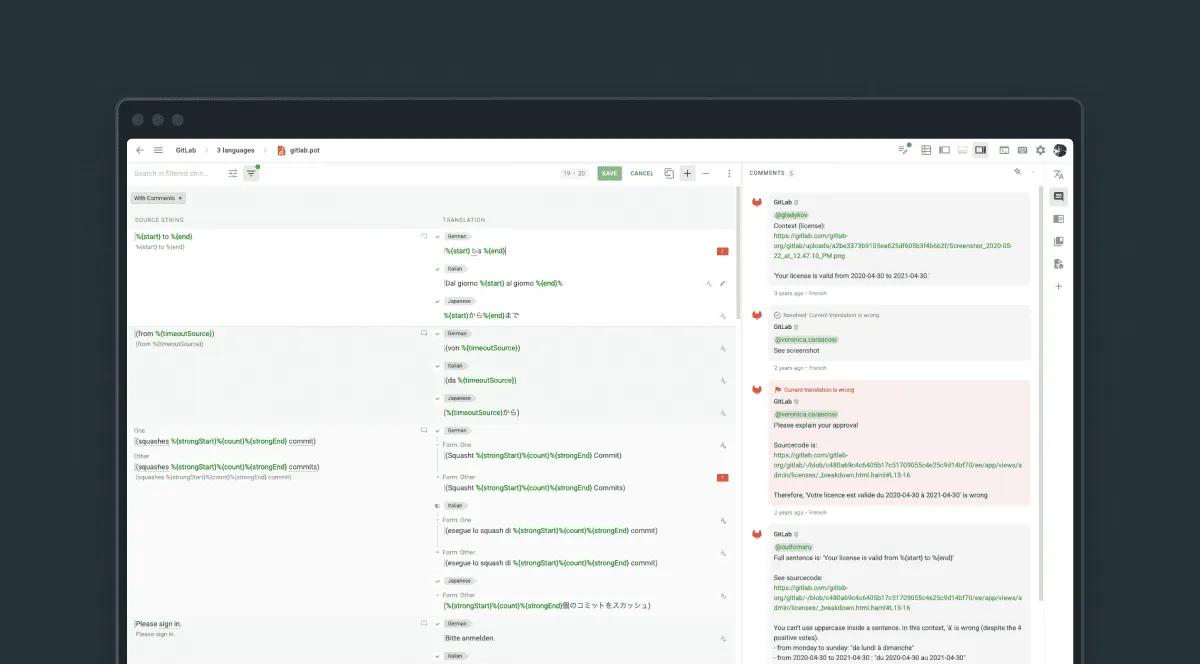
For Localization Managers
Your role shifts from managing files and deadlines to managing the process and the team.
- Set Up Automation Rules Configure Crowdin to automatically pull new content and assign it to the right translators. This frees you from manual file transfers and notifications.
- Monitor the Dashboard. Use the Crowdin reports to track translation progress, check on project health, and manage budgets in real time.
- Create a Review Workflow. Set up a multi-stage process where initial translations are reviewed by a second person for quality and accuracy.
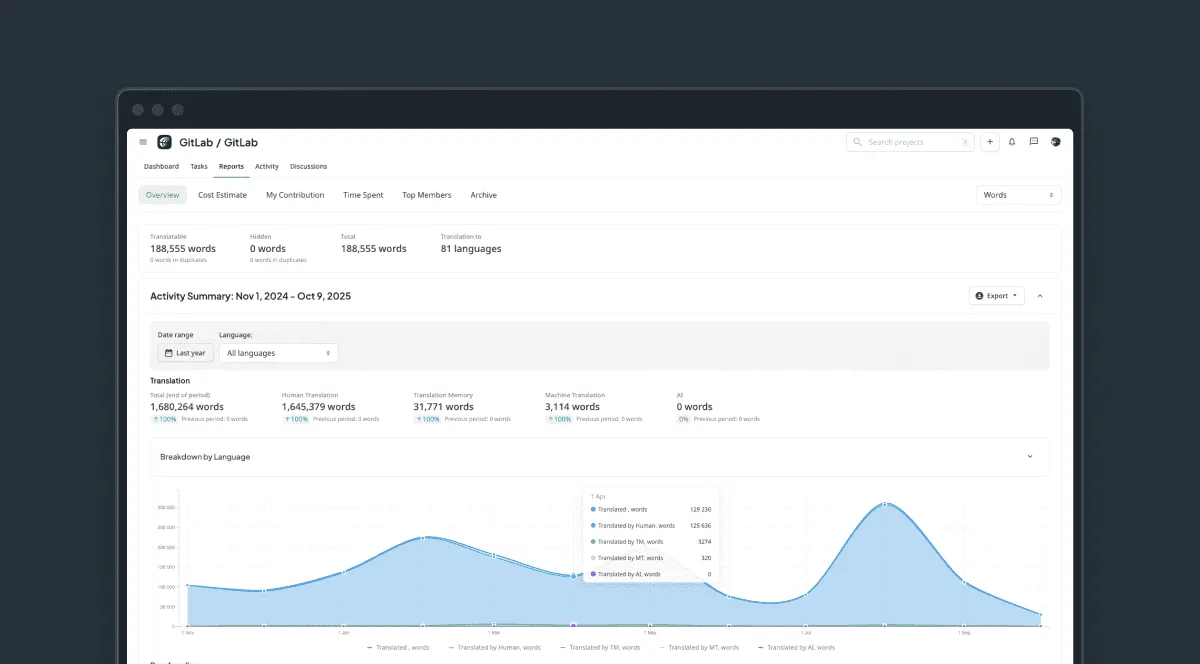
For Translators and Reviewers
Your work changes from big, one-off projects to small, incremental tasks.
- Work in Small, Steady Batches: Instead of waiting for a huge file, you’ll be notified of small batches of new strings. This allows you to work in a steady, manageable flow.
- Use the Tools: Always check the Translation Memory and Machine Translation suggestions. They are there to help you work faster and maintain consistency.
- Ask for Context: If a string is unclear, use the commenting feature to ask the developer for more information. This real-time collaboration guarantees you get the right translation the first time.
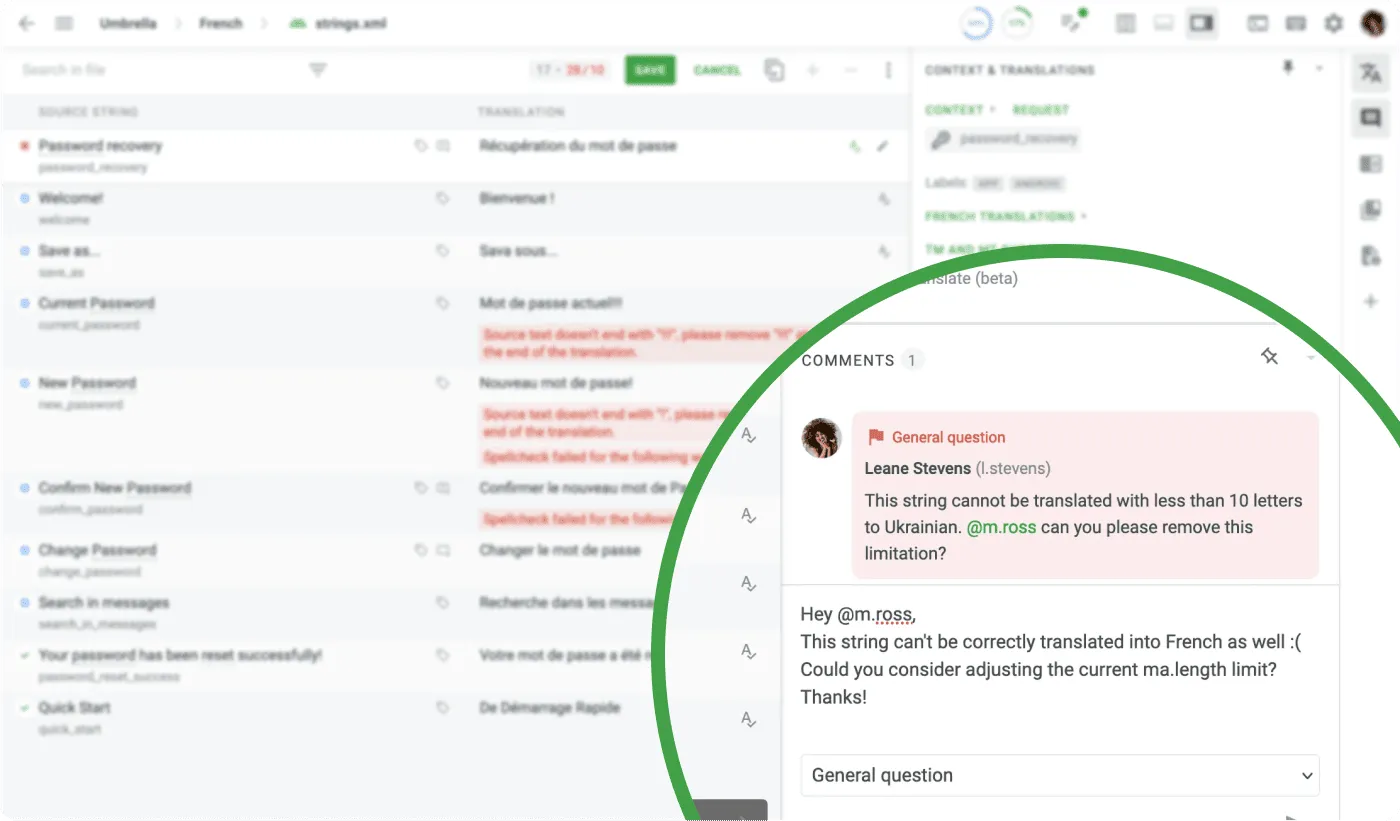
For Marketers
Your role is to ensure your message resonates, not just translates.
- Think in Transcreation: Your content isn’t just translated; it’s transcreated, сulturally adapted to fit a new market. Work with translators to ensure the tone, humor, and references are relevant.
- Provide Context for Campaigns: Don’t just send individual strings. Provide a brief for each campaign or piece of content, explaining the target audience and goal.
- Test Your Campaigns: Use Crowdin’s in-context feature to see how your translated copy looks on a live webpage or in an email. You can also work with your team to A/B test campaign messaging in each market.
Case Study: Semrush and Continuous Localization
Semrush, a SaaS platform with over 55 products and weekly updates, faced a major challenge: how to manage localization at a massive scale without creating bottlenecks.
The Solution
Semrush implemented a continuous localization workflow with Crowdin Enterprise. They automated the process by connecting Crowdin to their tools like GitHub, GitLab, Zapier, Figma, and Marketo. This ensures new content is automatically sent for translation as soon as it’s created.
To balance speed and quality, they classify content: high-impact content is translated by humans, while low-impact content is handled by machine translation with human review.
The Results
By using Crowdin Enterprise for a continuous workflow, Semrush can release new content simultaneously across all markets. Because of this, they were able to grow their operations, keep quality high, and improve teamwork across dozens of product teams. This also helped them avoid the delays that come with a traditional localization process.
Our clients can tell better: watch this episode of the Agile Localization Podcast about the Localization process in Semrush.
The Future is Continuous
Continuous localization is a necessity for any business with global ambitions. The old, linear waterfall model simply can’t keep pace with the agile, ever-evolving nature of modern digital products.
By adopting a continuous, automated workflow with a powerful platform like Crowdin, you can transform localization from a bottleneck into an integrated part of your development process. This approach allows you to:
- Release new features and products to all markets simultaneously.
- Reduce manual work and costs by leveraging automation with AI localization tools, Translation Memory and Machine Translation
- Ensure your global customers always have access to the latest, most accurate content.
Continuous Localization is for Teams with Frequent Product or Content Updates
Even if you want to create localized content every day, it won’t be a challenge. All you need is to set up localization that runs in parallel with product development and content creation cycles, rather than handle it afterwards as a separate process.
No matter how many strings you add a week, development and localization won’t stand in each other’s way, and you will be able to release updates in several languages simultaneously.
You can use Crowdin as a centralized place to manage all your source content and translations. Use add-ons and connectors to extend Crowdin functionality for your team. In Crowdin Marketplace, you can find platform integrations and services for engineers, marketers, customer support, and design teams.
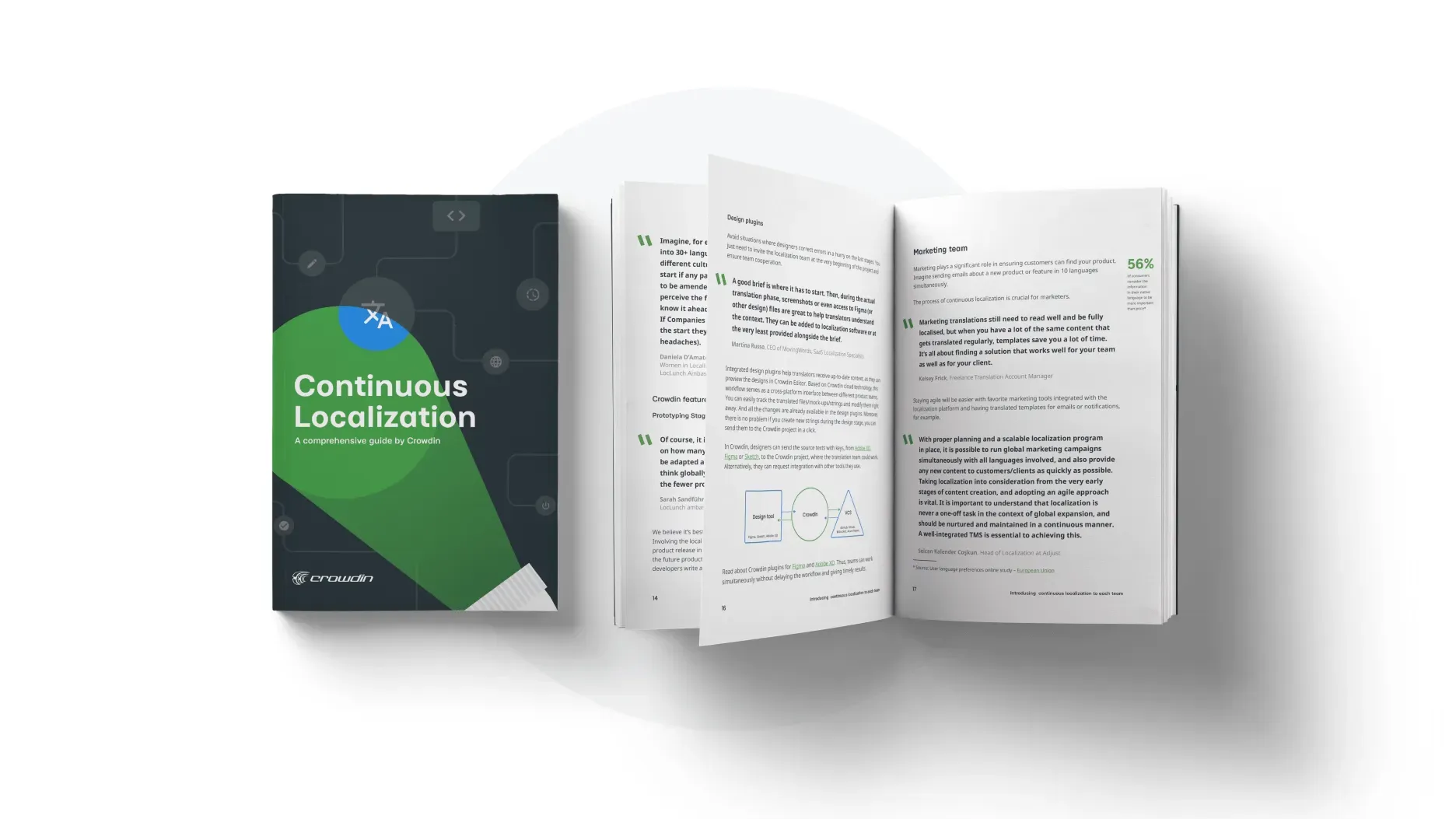
What’s in the “Continuous Localization for Your Team” e-book?
By reading our e-book, you can learn how continuous localization can help you to:
- Improve the localization process.
- Launch multilingual versions simultaneously.
- Reduce developer involvement in localization tasks you can automate.
- Start localization at the design stage.
- Update your sources and translations on your repo instantly.
- Ensure localization runs in parallel with development, not after.
- Avoid correcting localization errors after the release.
Elevate localization management for your team
FAQ
What is continuous localization?
Continuous localization is an approach that automates and integrates translation into the agile development workflow. Unlike the traditional “batch-and-wait” model, continuous localization ensures content is translated incrementally as it’s created, reducing time-to-market for global releases. The process is powered by automation, linking localization directly to your development tools, and fostering real-time collaboration among teams.
What type of content needs continuous localization?
Continuous localization is best for any digital content that is not static and is updated frequently.
This includes:
- Software and apps: UI text and new features that need to be translated as they are created to ensure simultaneous global releases.
- Websites and e-commerce: New blog posts, product descriptions, and landing pages that are constantly being updated.
- Gaming: New quests, dialogue, and items that need to be released to all players at the same time.
- Marketing materials: Content like email campaigns and social media posts that must be adapted for different cultures.
- Customer support content: FAQs and help articles that are often updated to keep information current.
Diana Voroniak
Diana Voroniak has been in the localization industry for over 4 years and currently leads a marketing team at Crowdin. She brings a unique perspective to the localization with her background as a translator. Her professional focus is on driving strategic growth through content, SEO, partnerships, and international events. She celebrates milestones, redesigns platforms, and spoils her dog and cat.
